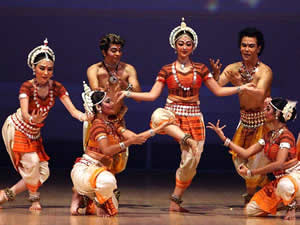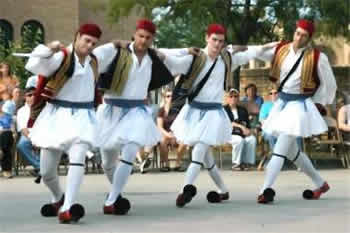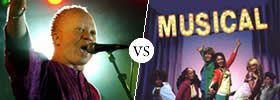Difference between Folk and Classical Dance
Key difference: Folk dancing is a simple dance form meant for group performance based on a reason like harvest of food, whereas classical dance is a form of enlightenment.
Dance is a type of art that involves movement of the body, rhythm and music. It is performed in many cultures as a form of emotional expression, social interaction, or exercise, in a spiritual or performance setting, and is sometimes used to express ideas or tell a story. Folk and Classical Dance are two examples of this form of expression. We understand the difference between the two.
 The FreeDictionary defines 'classical dance' as "a classical dance form characterized by grace and precision of movement and by elaborate formal gestures, steps, and poses," such as ballet. However, the term often commonly refers to the traditional Indian dances, including Kathak and Bharata Natyam.
The FreeDictionary defines 'classical dance' as "a classical dance form characterized by grace and precision of movement and by elaborate formal gestures, steps, and poses," such as ballet. However, the term often commonly refers to the traditional Indian dances, including Kathak and Bharata Natyam.
According to Wikipedia, in India, classical dance is a new umbrella term used to summarize the various art forms rooted together in Natya and the sacred Hindu musical theatre dance styles whose theory can be traced back to the Natya Shastra of Bharata Muni.
Classical Dances were performed inside the temple according to the rituals, which were called as Agama Nartanam. This dance form is classified as margi or the soul liberating dance. Dances were also performed in the royal courts to compliment the classical music being played in the honor of the king. This dance form was referred to as Carnatakam and it was considered as an intellectual art form.
The Natya Shastra which was authored by Bharata Muni, he mentions the names of classical dance forms which are not recognizable today, but in the book under the name of four Pravrittis, they are listed as: Dakshinatya, Audramagadhi, Avanti, and Panchali. All these traditional dance forms were not appreciated during the British colonial rule. It was in the middle of the 20th century, that these dance forms started gaining popularity.
The art of Natya includes nritta or dance proper, it has never been only limited to dancing and does include singing and abhinaya. These features are common in all the Indian classical dance styles. In the margi form, Nritta is composed of karanas, while the desi nritta mainly consists of adavus.
A dance style is classical to the extent it incorporates the Natya Shastra techniques. The only two temple dance styles that have their origin in Natya Shastra are Bharata Natyam and Odissi. These two most faithfully adhere to the Natya Shastra but currently do not include Vaachikaabhinaya (dialog acts), although some styles of Bharata Natyam, such as Melattur style, prescribe the lip and eye movements indicating Vaachikaabhinaya. Another example of Vaachikaabhinaya is Kuchipudi.
The term "Shastriya" means ‘classical’ in Sanskrit. It was introduced by Sangeet Natak Akademi to denote the Natya Shastra, which is based on performing art styles. A very important feature of these classical dances is the use of the ‘mudra’ or hand gestures by the artists as a shorthand sign language used to narrate a story and demonstrate certain concepts such as objects, weather, nature and emotions. Many classical dances include facial expressions as an integral part of the dance form.

People define folk dancing as dancing for which there is no governing of body. The term ‘folk dance’ is sometimes applied to dances of historical importance in European culture and history. They originated before the 20th century. For other cultures the terms ‘ethnic dance’ or ‘traditional dance’ are used sometimes, although the latter terms include the ceremonial dances.
According to Wikipedia, The folk dance describes dances that share few of the following attributes:
- Dances which are performed at the social functions by people with little or no professional training at all, often based on traditional music.
- These dances not generally designed for public performance or the stage though they may later be arranged or designed to set for stage performances.
- Though folk traditions change over time, dance execution is dominated by an inherited tradition rather than an innovation in the dance.
- New dancers often learn the informal way, which is by observing others or receiving help from others.
The terms "ethnic" and "traditional" are used when it is required to emphasize the cultural roots of the dance. In the sense, all folk dances are considered as ethnic ones. Not all ethnic dances are folk dances, for example ritual dances or dances of ritual origin are not considered to be folk dances. Ritual dances are usually called as ‘Religious dances’ because of their purpose.
Folk dance is generally considered as ‘street dance’ or ‘vernacular dance’. It does not evolve spontaneously. These dances were bound by tradition and originated in the time when there existed a difference between the dances of the ‘common people’ and the ‘high society’ dances of the rich people.
A number of modern ballroom dances originated from folk ones. A few examples are: English Country Dance, Turkish Dance, Greek Dances, etc.
Comparison between Folk and Classical Dance:
|
|
Folk Dance |
Classical Dance |
|
Definition |
Folk dancing is a simple dance form meant for group performance created for a reason like harvest of food. |
Classical dance forms are characterized by grace and precision of movement and by elaborate formal gestures, steps, and poses. Indian Classical Dances are for enlightenment and are based on Natya Shastra. |
|
Dance form |
It is a recent movement that values the traditional dances of various peoples. |
It is a dance that is highly stylized and intended for performance. |
|
Society |
Folk dances are common people's dances. |
Classical dance is developed in the high society circles. |
|
Storyline |
Folk dancing is funnier and free. It usually has a story line to the dance. |
Classical dance is more demanding and is usually strict with technical aspects. |
|
About |
Folk dances are all about energy, enthusiasm and power. |
Classical dances are more about grace and composure. |
|
Dancers |
Folk dances are based on traditions where the people dance and are not "professional" dancers. |
Classical dances are performed by professional or highly trained dancers who have studied their form for many years. |
|
Example |
Kalbelia, Chari, Ghoomer, Fire and Kacchi Gori Dance. |
Ballet, Bharatnatyam of Tamil Nadu, Mohiniaattam of Kerala, Kuchipudi of Andhra Pradesh. |
Image Courtesy: dances.iloveindia.com, protorestaurantgroup.com









Add new comment